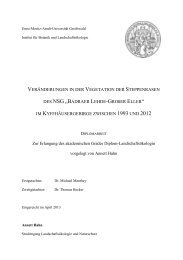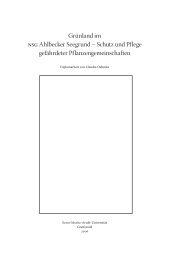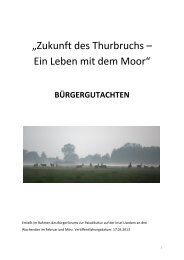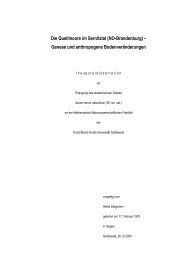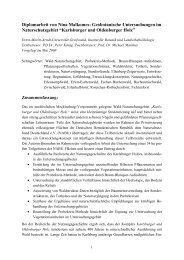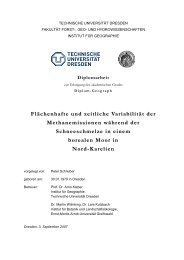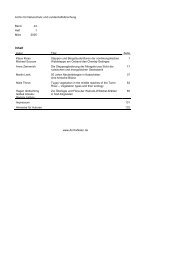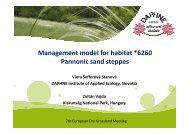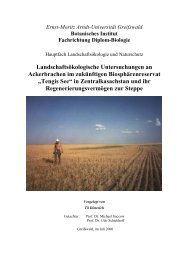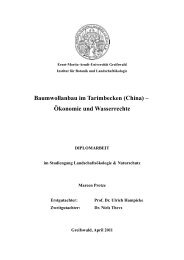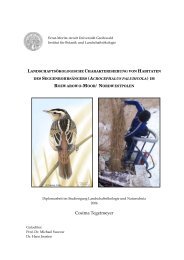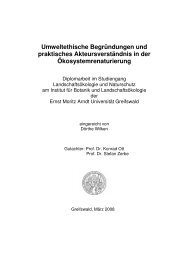Structure, reproduction and flood-induced dynamics of riparian ...
Structure, reproduction and flood-induced dynamics of riparian ...
Structure, reproduction and flood-induced dynamics of riparian ...
You also want an ePaper? Increase the reach of your titles
YUMPU automatically turns print PDFs into web optimized ePapers that Google loves.
<strong>Structure</strong>, <strong>reproduction</strong> <strong>and</strong><br />
fl ood-<strong>induced</strong> <strong>dynamics</strong> <strong>of</strong> <strong>riparian</strong><br />
Tugai forests at the Tarim River in<br />
Xinjiang, NW China<br />
NIELS THEVS 1 * , STEFAN ZERBE 1 , MARTIN SCHNITTLER 1 ,<br />
NURBAY ABDUSALIH 2 <strong>and</strong> MICHAEL SUCCOW 1<br />
1 Institute <strong>of</strong> Botany <strong>and</strong> L<strong>and</strong>scape Ecology, University Greifswald, Grimmer Strasse 88, D-17487 Greifswald,<br />
Germany<br />
2 Institute <strong>of</strong> Resource <strong>and</strong> Environmental Sciences, Xinjiang University, Shengli Lu 14, 830046 Urumqi, China<br />
* Corresponding author. E-mail: niels.thevs@uni-greifswald.de<br />
Summary<br />
Tugai forests are the <strong>riparian</strong> forests along the rivers in the continental desert regions <strong>of</strong> Central<br />
Asia, i.e. the Tarim River, Amu Darya <strong>and</strong> Syr Darya. They mainly consist <strong>of</strong> Populus euphratica<br />
Oliv., Populus pruinosa Schrenk. <strong>and</strong> Elaeagnus oxycarpa Schltdl. As a consequence <strong>of</strong> l<strong>and</strong> opening<br />
campaigns, large areas <strong>of</strong> Tugai forests were destroyed after the 1950s. Due to excessive use <strong>of</strong><br />
water for irrigation, the remaining Tugai forests are under severe threat. Near natural Tugai forests<br />
still exist along the Tarim middle reaches in the Tarim Huyanglin Nature Reserve, Xinjiang, NW<br />
China. There is a gap in underst<strong>and</strong>ing, how the seedlings <strong>of</strong> P. euphratica establish as trees which<br />
continuously connect to the groundwater. Therefore, the set <strong>of</strong> conditions which must be met for<br />
germination <strong>and</strong> successful establishment, i.e. formation <strong>of</strong> Tugai forests, was investigated along<br />
a representative transect still under natural conditions. P. euphratica seedlings germinate in belts<br />
during the retreat <strong>of</strong> the summer fl ood on freshly deposited sites bare <strong>of</strong> other vegetation. Such<br />
germination sites are formed by river <strong>dynamics</strong>. While germination takes place regularly in the<br />
study area, successful establishment is restricted to few germination events. Seedlings face dropping<br />
groundwater levels during spring <strong>and</strong> early summer <strong>of</strong> the second year after germination. Therefore,<br />
for successful establishment, it is essential that the fl ood <strong>of</strong> the second year starts in time <strong>and</strong> is high<br />
enough, in order to replenish the groundwater. Furthermore, clayey soil layers in the subsoil may<br />
play a role for successful establishment, too, as they store water better than s<strong>and</strong>y soil layers.<br />
Introduction<br />
Tugai forests are the <strong>riparian</strong> forests along the rivers<br />
in the continental, winter-cold deserts <strong>of</strong> Central<br />
Asia, i.e. along the Tarim River in the Tarim<br />
Basin as well as the Amu Darya <strong>and</strong> Syr Darya in<br />
the Aral Sea Basin. They mainly consist <strong>of</strong> Populus<br />
euphratica Oliv., Populus pruinosa Schrenk. <strong>and</strong><br />
Elaeagnus oxycarpa Schltdl. ( Tian, 1991 ; Ogar,<br />
2003 ). Tugai forests are associated with shrub<br />
communities (mainly Tamarix species) <strong>and</strong> grassl<strong>and</strong><br />
vegetation, i.e. Phragmites australis Trin.<br />
© Institute <strong>of</strong> Chartered Foresters, 2008. All rights reserved. Forestry, Vol. 81, No. 1, 2008. doi:10.1093/forestry/cpm043<br />
For Permissions, please email: journals.permissions@oxfordjournals.org Advance Access publication date 5 February 2008
46<br />
ex Staud.( Ogar, 2003 ; Thevs et al. , 2007 ; Thevs<br />
et al. , in press ). The plant species <strong>of</strong> the Tugai<br />
forests <strong>and</strong> associated plant communities are socalled<br />
phreatophytes. They depend on groundwater<br />
or phreatic water along riverbanks, piedmont<br />
springs <strong>and</strong> lake shores. Along the middle <strong>and</strong><br />
lower reaches <strong>of</strong> the Tarim River, the Tugai forests<br />
almost exclusively consist <strong>of</strong> the tree species<br />
P. euphratica ( Wang et al. , 1996 ). Consequently,<br />
P. euphratica is a keystone species ( Bond, 1994 ) <strong>of</strong><br />
these <strong>riparian</strong> forests. We refer to the term Tugai<br />
forests commonly used by researchers who work<br />
on <strong>riparian</strong> ecosystems <strong>of</strong> Central Asia.<br />
From a global perspective, Tugai forests are a<br />
unique <strong>and</strong> threatened fl ood plain ecosystem. In<br />
the desert regions <strong>of</strong> Central Asia, these forests<br />
are an important habitat for plant <strong>and</strong> animal<br />
life <strong>and</strong> contain the highest biodiversity in these<br />
regions ( Thevs, 2005 ; Thevs et al. , 2005 ; Thevs,<br />
2006 ). Additionally, these fl ood plain forests are<br />
a major natural resource for their human populations<br />
<strong>and</strong> provide environmental benefi ts such as<br />
l<strong>and</strong>scape preservation, wind protection, stabilization<br />
<strong>of</strong> moving s<strong>and</strong> <strong>and</strong> soil <strong>and</strong> riverbank stabilization<br />
( Weissgerber, 1994 ; Zerbe et al. , 2005 ;<br />
Thevs et al. , 2007 ). At present, the world ’ s largest<br />
contiguous Tugai forests occur along the Tarim<br />
River <strong>and</strong> its tributaries in the Tarim basin ( Wang<br />
et al. , 1996 ). However, the total area <strong>of</strong> Tugai forests<br />
in the Tarim basin declined from ~ 500 000 ha<br />
in 1958 to ~ 200 000 ha in 1978 ( Huang, 1986 ).<br />
In the Aral Sea Basin, the area <strong>of</strong> Tugai forests<br />
shrunk from ~ 500 000 ha in 1950 to ~ 70 000 ha in<br />
1998 ( Treshkin, 2001 ). Compared with the other<br />
plant communities <strong>of</strong> the Tugai vegetation, the<br />
Tugai forests are the most threatened ecosystem<br />
( Wang et al. , 1996 ; Treshkin, 2001 ). The Tugai<br />
forests were destroyed directly in order to gain<br />
new farml<strong>and</strong> <strong>and</strong> indirectly as a consequence <strong>of</strong><br />
excessive use <strong>of</strong> the water resources for irrigation.<br />
The restoration <strong>of</strong> such unique forest ecosystems<br />
is <strong>of</strong> worldwide signifi cance ( Zerbe, 2002 ; van<br />
Andel <strong>and</strong> Aronson, 2005 ).<br />
Comprehensive surveys on the biology <strong>and</strong><br />
ecology <strong>of</strong> P. euphratica are given by Huang<br />
(1986) , Xinjiang Linkeyuan Zaolin Zhisha<br />
Yanjiusuo (1989) , Xinjiang Ziyuan Kaifa Zonghe<br />
Kaocha Dui (1989) , China Ministry <strong>of</strong> Forestry<br />
(1990) , Liu et al. (1990) <strong>and</strong> Wang et al. (1996) .<br />
Populus euphratica is an obligate phreatophyte<br />
( Zeng et al. , 2002 ; Gries et al. , 2003 ; Foetzki,<br />
FORESTRY<br />
2004 ), which means it must continuously have<br />
groundwater contact for survival. The maximum<br />
groundwater depth for the survival <strong>of</strong> P. euphratica<br />
is estimated as 10 – 13 m, according to a literature<br />
review by Thevs (2005) . Populus euphratica<br />
follows two reproductive strategies, i.e. generative<br />
<strong>and</strong> clonal <strong>reproduction</strong> ( Xinjiang Linkeyuan<br />
Zaolin Zhisha Yanjiusuo, 1989 ; Xinjiang Ziyuan<br />
Kaifa Zonghe Kaocha Dui, 1989 ; China Ministry<br />
<strong>of</strong> Forestry, 1990 ; Wang et al. , 1996 ; Saito et al. ,<br />
2002 ; Bruelheide et al. , 2004 ; Westermann et al. ,<br />
in press ).<br />
The seeds are light, have pappus-like hairs, <strong>and</strong><br />
are dispersed by wind <strong>and</strong> water. The main fruiting<br />
period is during the fl ooding period <strong>of</strong> the<br />
Tarim River, i.e. between July <strong>and</strong> September.<br />
Germination <strong>and</strong> establishment depend on freshly<br />
deposited riverbanks, mostly accreting riverbanks.<br />
Experiments confi rmed that optimal germination<br />
occurs under conditions <strong>of</strong> high light, a temperature<br />
between 25°C <strong>and</strong> 30°C <strong>and</strong> water-saturated<br />
soils with a salt content lower than 0.2 per cent.<br />
Under such conditions, the germination rate exceeds<br />
80 per cent ( Xinjiang Linkeyuan Zaolin<br />
Zhisha Yanjiusuo, 1989 ). Germination occurs in<br />
lines or narrow strips marking fl ood water lines<br />
at the riverbank <strong>and</strong> depends on a moving river<br />
channel ( China Ministry <strong>of</strong> Forestry, 1990 ; Liu<br />
et al. , 1990 ). As river courses move, the sites continuously<br />
change from wet (frequently fl ooded) to<br />
dry. These different groundwater levels are indicated<br />
by different plant species ( Thevs, 2005 , 2006 ;<br />
Zerbe <strong>and</strong> Thevs, 2007 ; Thevs et al. , in press ).<br />
Riparian forests in the arid <strong>and</strong> semiarid western<br />
USA (so-called cottonwoods) as described by<br />
Braatne et al. (1996) appear similar to the Tugai<br />
forests considering basic mechanisms <strong>of</strong> regeneration<br />
<strong>and</strong> the environmental conditions: the<br />
main tree species <strong>of</strong> these forests are also phreatophytes<br />
( Smith et al. , 1998 ). The seeds are dispersed<br />
also during the fl ood <strong>and</strong> germinate on<br />
riverbanks after the fl ood. The fl ood peak occurs<br />
in April – May, when water level rises by 2 – 3 m.<br />
Seedling survival is signifi cantly enhanced by<br />
clayey soil layers in the subsoil <strong>and</strong> by summer<br />
precipitation. Ice scoring during the winter may<br />
erode a signifi cant number <strong>of</strong> seedlings ( Rood<br />
et al. , 1998 ; Cooper et al. , 1999 ; Stromberg,<br />
2001 ). Thus, a set <strong>of</strong> conditions must be met for<br />
germination <strong>and</strong> survival <strong>of</strong> the seedlings in the<br />
cottonwoods: coinciding time <strong>of</strong> fl ood retreat
<strong>and</strong> seed dispersal, freshly deposited riverbanks<br />
as germination sites, additional summer rainfall,<br />
clayey soil layers in the subsoil <strong>and</strong> germination<br />
sites located high enough to avoid ice scoring.<br />
The Tugai forests face harsher environmental<br />
conditions than the cottonwoods. The water<br />
level during fl oods rises 3 – 4 m. The fl ood season<br />
<strong>and</strong> the time <strong>of</strong> seed dispersal occur from July to<br />
September ( Song et al. , 2000 ). Seedlings thus<br />
have to survive the winter shortly after germination.<br />
Furthermore, there are no signifi cant additional<br />
rainfall events, as the annual precipitation<br />
does not exceed 50 mm ( Weili Xian Difangzhe<br />
Bianzuan Weiyuanhui, 1993 ).<br />
The patterns <strong>of</strong> <strong>reproduction</strong> <strong>and</strong> forest formation<br />
<strong>of</strong> the cottonwoods therefore cannot be<br />
directly applied to the Tugai forests <strong>and</strong> there<br />
is a gap in underst<strong>and</strong>ing how do seedlings <strong>of</strong><br />
P. euphratica establish as trees which continuously<br />
connect to the groundwater. Our objective was to<br />
identify the set <strong>of</strong> conditions which must be met<br />
for germination <strong>and</strong> successful establishment, i.e.<br />
FLOOD-INDUCED DYNAMICS OF TUGAI FORESTS 47<br />
formation <strong>of</strong> Tugai forests, based on the knowledge<br />
inherited from the cottonwoods. As a case<br />
study, we investigated the river course movement<br />
<strong>of</strong> the Tarim during the past decades, recent fl ood<br />
events, soil texture <strong>and</strong> the structure <strong>and</strong> spatial<br />
distribution <strong>of</strong> vegetation types along a representative<br />
transect still under natural conditions.<br />
This study has to be seen against the background<br />
<strong>of</strong> recent constructions <strong>of</strong> lateral dykes<br />
along the middle reaches <strong>of</strong> the Tarim River in<br />
2004. Water is channelled through these dykes<br />
down to the drought-prone lower reaches <strong>of</strong> the<br />
Tarim River ( Song et al. , 2000 ; Giese et al. , 2005 ,<br />
Westermann et al. , in press ).<br />
Study area<br />
The transect chosen for this study is located in the<br />
western part <strong>of</strong> the Tarim Huyanglin Nature Reserve<br />
at the middle reaches <strong>of</strong> the Tarim River near<br />
the settlement Iminqäk ( Figure 1 ). The transect<br />
Figure 1 . Location <strong>of</strong> the investigation area in South Xinjiang, NW China with the Tarim River <strong>and</strong> the<br />
Tarim Huyanglin Nature Reserve, location between the latitude <strong>of</strong> 40° 55 ′ N <strong>and</strong> 41° 15 ′ N <strong>and</strong> longitude<br />
<strong>of</strong> 84° 15 ′ E <strong>and</strong> 85° 30 ′ E.
48<br />
stretches between 41° 12.1 ′ N, 84° 22.9 ′ E <strong>and</strong><br />
41° 12.5 ′ N, 84° 22.0 ′ E.<br />
The Tarim river system is located at the northern<br />
edge <strong>of</strong> the Taklamakan Desert, which is<br />
337 600 km 2 <strong>and</strong> the second largest s<strong>and</strong> desert<br />
<strong>of</strong> the world ( Zhu, 1986 ). The Tarim basin is<br />
equivalent to the southern part <strong>of</strong> the Xinjiang<br />
province, NW China. It is bordered by the mountain<br />
ranges <strong>of</strong> the Tian Shan in the north <strong>and</strong><br />
northeast, the Pamir in the west <strong>and</strong> the Kunlun<br />
(Kurum) Mountains <strong>and</strong> Tibetan Plateau, respectively,<br />
in the south <strong>and</strong> southeast ( Figure 1 ). Some<br />
<strong>of</strong> the surrounding mountain ranges exceed 7000 m<br />
above sea level. Consequently, all humid air currents<br />
are cut <strong>of</strong>f <strong>and</strong> the climate is continentalarid<br />
with a mean annual precipitation <strong>of</strong> less than<br />
50 mm <strong>and</strong> a mean annual potential evapotranspiration<br />
<strong>of</strong> more than 2500 mm. In January, the<br />
average air temperature is − 9°C <strong>and</strong> 25°C in July,<br />
thus also refl ecting the strong continental character<br />
<strong>of</strong> the climate ( Weili Xian Difangzhe Bianzuan<br />
Weiyuanhui, 1993 ; Yuan <strong>and</strong> Li, 1998 ; Xinjiang<br />
Weiwuer Zizhiqu Shuili Ting <strong>and</strong> Xinjiang Shuili<br />
Xuehui, 1999 ).<br />
The Tarim River, with a total length <strong>of</strong> 1321<br />
km, is fed by melt water <strong>and</strong> precipitation in the<br />
mountains through its three tributaries Aksu,<br />
Hotan <strong>and</strong> Yarkant. The river used to end in the<br />
Taitema Lake, but it has not reached this lake for<br />
the last 30 years, because all water entering the<br />
Tarim lower reaches was diverted for irrigation.<br />
About 75 per cent <strong>of</strong> the annual run <strong>of</strong>f <strong>of</strong> the<br />
Tarim River is concentrated in the months July,<br />
August <strong>and</strong> September ( Figure 2 ) resulting in annual<br />
summer fl ood periods. The annual discharge<br />
varies from year to year. Each fl ood event transports<br />
huge loads <strong>of</strong> sediments into the large alluvial<br />
plain <strong>and</strong> thus continuously raises the river’s<br />
base level ( Xia, 1998 ). Every fl ood changes the<br />
river course, erodes l<strong>and</strong> <strong>and</strong> forms new riverbanks<br />
<strong>and</strong> opens new river branches or closes existing<br />
ones. Extraordinary fl oods can even open<br />
entirely new river courses or close river courses<br />
( Figure 3 ; see also Zhou, 1989 ).<br />
In the rather level fl ood plain along the middle<br />
reaches, the Tarim River has formed a wide inl<strong>and</strong><br />
delta with a web <strong>of</strong> braided branches. However,<br />
due to diversion <strong>of</strong> water for irrigation <strong>and</strong> river<br />
management, the fl ood <strong>dynamics</strong> have lost much<br />
<strong>of</strong> its former strength. The most dynamic part <strong>of</strong><br />
the Tarim River now lies in the western part <strong>of</strong><br />
FORESTRY<br />
Figure 2 . Monthly run<strong>of</strong>f <strong>of</strong> the Tarim River at Yengi<br />
Bazar from 1992 to 2005 (data provided by Tarim<br />
Watershed Administration Bureau, Korla, China).<br />
Figure 3 . Changes <strong>of</strong> the Tarim River course along<br />
the middle reaches <strong>of</strong> the Tarim according to Hedin<br />
(1905) <strong>and</strong> Zhonghua Renmin Gongheguo Guojia<br />
Tuciju (1959) <strong>and</strong> L<strong>and</strong>sat Multispectral Scanner<br />
(path 155, row 31), 20 October 1973, L<strong>and</strong>sat Enhanced<br />
Thematic Mapper (path 144, row 31), 06<br />
July 2000 images.<br />
the Tarim Huyanglin Nature Reserve around<br />
Iminqäk ( Figures 1 <strong>and</strong> 4 ), because no lateral dyke<br />
(cf. Introduction) has been built there ( Yuan <strong>and</strong><br />
Li, 1998 ; Xinjiang Talimu Huyang Ziranbaohuqu<br />
Guanlizhan, 2002 ; Thevs, 2005 ).<br />
Methods<br />
The study was conducted on a representative transect<br />
<strong>of</strong> 900 m length perpendicular to the Tarim
River near Iminqäk (Bügür County) in the Tarim<br />
Huyanglin Nature Reserve. We have chosen a<br />
representative reach <strong>of</strong> the Tarim River which has<br />
maintained its natural dynamic ( Figure 4 ). River<br />
course changes were traced through satellite images<br />
<strong>and</strong> personal observations in the fi eld ( Table 1 ).<br />
The satellite image from 2001, L<strong>and</strong>sat Enhanced<br />
Thematic Mapper (ETM) was rectifi ed based on<br />
street crossings as reference points. The rectifi ed<br />
image was projected into the Universal Transverse<br />
Mercator coordinate system (zone T 45). The<br />
geographical positions <strong>of</strong> the street crossings were<br />
measured using a Garmin 12 Global Positioning<br />
System. The other satellite images were aligned to<br />
the rectifi ed satellite image from 2001.<br />
To characterize the soils, seven pr<strong>of</strong>i les were<br />
drilled in July 2004. The locations <strong>of</strong> the soil pr<strong>of</strong>i<br />
les are shown in Figure 5 . The soil pr<strong>of</strong>i les were<br />
drilled as deep as the groundwater layer at base<br />
Figure 4 . River course <strong>of</strong> the Tarim River around<br />
Iminqak in 1973, 1992 <strong>and</strong> 2001 derived from<br />
L<strong>and</strong>sat Multispectral Scanner (path 155, row 31,<br />
20 October 1973), L<strong>and</strong>sat Thematic Mapper (path<br />
144, row 31, 26 September 1992) <strong>and</strong> L<strong>and</strong>sat Enhenced<br />
Thematic Mapper (path 144, row 31, 10<br />
August 2001) images.<br />
FLOOD-INDUCED DYNAMICS OF TUGAI FORESTS 49<br />
fl ow <strong>of</strong> the Tarim River in July 2004, i.e. between<br />
155 <strong>and</strong> 500 cm. Soil texture was recorded in the<br />
fi eld for all horizons according to the fi eld estimation<br />
key for soil texture <strong>of</strong> the Boden (1994) . This<br />
fi eld estimation key for soil texture is based on<br />
the stickiness <strong>and</strong> plasticity <strong>of</strong> a moist soil sample<br />
<strong>and</strong>, on principle, is a similar approach as by<br />
Brady <strong>and</strong> Weil (1999) . The key employed here<br />
( Boden, 1994 ) is based on the following ranges <strong>of</strong><br />
grain sizes for s<strong>and</strong>, silt <strong>and</strong> clay: s<strong>and</strong> 2000-63<br />
μ m, silt 63-2 μ m <strong>and</strong> clay below 2 μ m. Additionally,<br />
in July 2003, the elevation was measured<br />
along a line, connecting all seven soil pr<strong>of</strong>i les<br />
using a levelling device <strong>and</strong> a rod. The zero elevation<br />
base was the base fl ow in July 2004.<br />
Along the transect, vegetation was mapped in<br />
a 100-m wide strip in September 2004. The vegetation<br />
map was digitized using the cartography<br />
s<strong>of</strong>tware Polyplot 5.4 ( www.polyplot.de ). The<br />
map units <strong>of</strong> the vegetation map were vegetation<br />
types, which were derived from their dominant<br />
species <strong>and</strong> which are commonly used by Chinese<br />
scientists (according to the literature survey by<br />
Thevs, 2005 ). The nomenclature <strong>of</strong> the species<br />
followed Hudaberdi <strong>and</strong> Xu (2000) . The transect<br />
cuts through rows <strong>of</strong> P. euphratica trees, which<br />
we consider originated from germination events.<br />
The age <strong>of</strong> tree rows was determined by analysing<br />
tree cores, taken at a height <strong>of</strong> 35 cm with a<br />
Suunto tree corer <strong>of</strong> 5 mm diameter in September<br />
2004. The 10 tallest trees were chosen from the<br />
tree row in the belt <strong>of</strong> the vegetation map. The<br />
presence <strong>of</strong> P. euphratica seedlings was mapped<br />
every September from 2004 until 2006.<br />
In 2002, 2003 <strong>and</strong> 2004, the area fl ooded<br />
during the summer fl ood was recorded in the<br />
fi eld. Data on daily water run<strong>of</strong>f at Yengi Bazar<br />
(about 30 km upstream <strong>of</strong> the transect) from<br />
Table 1 : Data sources for tracing the river course changes <strong>of</strong> the Tarim River near the settlement <strong>of</strong> Iminqäk in<br />
the western part <strong>of</strong> the Tarim Huyanglin Nature Reserve<br />
Dating <strong>of</strong> fl oods Source<br />
Flood in 1973 L<strong>and</strong>sat MSS (path 155, row 31), 20 October 1973, retrieved from www.l<strong>and</strong>sat.org<br />
Flood in 1992 L<strong>and</strong>sat TM (path 144, row 31), 26 September 1992, retrieved from www.l<strong>and</strong>sat.org<br />
Base fl ow in 2000 L<strong>and</strong>sat ETM (path 144, row 31), 06 July 2000, purchased from GAF, Germany<br />
Flood in 2001 L<strong>and</strong>sat ETM (path 144, row 31), 10 August 2001, purchased from GAF, Germany<br />
Base fl ow in 2004 N. Thevs, personal observation<br />
Base fl ow in 2005 Quickbird image, 15 June 2005, purchased from GAF, Germany<br />
MSS = Multispectral Scanner, TM = Thematic Mapper, ETM = Enhanced Thematic Mapper.
50<br />
Figure 5 . The transect investigated, with its seven<br />
soil pr<strong>of</strong>i les <strong>and</strong> the location <strong>of</strong> the Tarim River<br />
course during fl ood 1973, 1992 <strong>and</strong> 2001 <strong>and</strong> base<br />
fl ow 2000, 2004 <strong>and</strong> 2005, cf. Table 1 .<br />
1992 to 2005 were kindly provided by the Tarim<br />
Watershed Bureau. Data on annual run<strong>of</strong>f were<br />
available from 1957 to 1991. At 10 August 2002,<br />
the fl ood line was recorded at the transect between<br />
sites no. 3 <strong>and</strong> 5 ( Figure 5 ). Furthermore,<br />
the riverbank at site no. 2 was fl ooded too. The<br />
corresponding run<strong>of</strong>f at Yengi Bazar was 446 m 3<br />
s − 1 at 10 August 2002. Through this threshold,<br />
we were able to roughly trace back how long the<br />
parts <strong>of</strong> the transect with a low elevation were<br />
fl ooded in each year after 1991.<br />
Results<br />
Reconstructed river course changes<br />
The location <strong>of</strong> the Tarim River main course during<br />
the fl ood periods in 1973, 1992 <strong>and</strong> 2001 as<br />
well as the base fl ow in 2000, 2004 <strong>and</strong> 2005 in<br />
relation to the transect is shown in Figure 5 . The<br />
channel changed its course from the location <strong>of</strong><br />
sites no. 4 <strong>and</strong> 5 towards the south between the<br />
years 1973 <strong>and</strong> 1992. Since then, it has moved<br />
gradually southward <strong>and</strong> relocated the me<strong>and</strong>er<br />
shown in Figure 5 , forming a wide accreting riverbank.<br />
In 1992, the Tarim River fl owed between<br />
sites no. 2 <strong>and</strong> 3. Site no. 3 was situated close<br />
to the northern bank <strong>of</strong> the Tarim River <strong>and</strong> site<br />
no. 2 close to the southern bank. Currently, site<br />
no. 2 clearly is located on the northern riverbank<br />
FORESTRY<br />
<strong>and</strong> the levee with the highest elevation had been<br />
formed there. The Tarim River migrated signifi -<br />
cantly during the past 30 years ( Figures 5 <strong>and</strong> 6 ).<br />
Soil properties <strong>and</strong> relief<br />
The soil horizons <strong>of</strong> all seven pr<strong>of</strong>i les with their<br />
texture are shown in Figure 6 . The soil pr<strong>of</strong>i les at<br />
the sites no. 1 <strong>and</strong> 2 consist <strong>of</strong> sediments from the<br />
Tarim River which were deposited after 1992 (cf.<br />
the relocation <strong>of</strong> the Tarim River from 1992 onwards<br />
in Figure 6 ) <strong>and</strong> mainly consist <strong>of</strong> s<strong>and</strong> <strong>and</strong><br />
silt. In pr<strong>of</strong>i le no. 1, no horizon <strong>of</strong> fi ne sediment<br />
like clay or clayey silt were recorded, while in pr<strong>of</strong>i<br />
le no. 2, a horizon <strong>of</strong> clayey silt not exceeding<br />
10 cm was found. In soil pr<strong>of</strong>i le no. 3, we observed<br />
a rather thick clayey horizon <strong>of</strong> 85 cm in the subsoil,<br />
but silt in the topsoil. The soil pr<strong>of</strong>i les <strong>of</strong> sites<br />
no. 4 <strong>and</strong> 5 had a top horizon with clayey silt <strong>and</strong><br />
clay, respectively, <strong>and</strong> showed fi ne-grained horizons<br />
<strong>of</strong> clayey silt <strong>and</strong> clay in the subsoil. In particular<br />
in pr<strong>of</strong>i le no. 5, fi ne-grained horizons were<br />
characteristic throughout the whole pr<strong>of</strong>i le.<br />
The levee at site no. 2 <strong>and</strong> the terrace next to<br />
site no. 5 are the highest points <strong>of</strong> the transect,<br />
not considering the dunes around site no. 7. From<br />
the levee at site no. 2 towards site no. 3, the elevation<br />
decreases slightly. Site no. 3 lies in between<br />
two fl at levees. Between site no. 3 <strong>and</strong> the terrace<br />
at site 5, the transect is bowl shaped ( Figure 6 ).<br />
Flood plain vegetation<br />
The distribution <strong>of</strong> the vegetation along the transect<br />
from the current river course towards the hinterl<strong>and</strong><br />
can be described as follows ( Figure 6 ):<br />
1 Myricaria pulcherrima Batalin. reed: this vegetation<br />
type formed a belt along the current<br />
levee on the accreting riverbank ( Figure 7 ).<br />
Here, narrow belts (0.6 – 1 m wide each) <strong>of</strong><br />
P. euphratica seedlings <strong>and</strong> saplings were<br />
found. One group <strong>of</strong> seedling belts had germinated<br />
in 2002, but did not survive until<br />
autumn 2004. Site no. 2, sampled in 2004,<br />
was located on the levee within a belt <strong>of</strong> P. euphratica<br />
seedlings. Another strip <strong>of</strong> seedlings<br />
was found in 2006, which had germinated in<br />
2005. These seedlings survived till autumn<br />
2006.
2 Calamagrostis pseudophragmites Link ex<br />
Rchb. reed: towards the hinterl<strong>and</strong>, the<br />
M. pulcherrima reed is replaced by C. pseudophragmites<br />
( Figure 7 ). Within this vegetation,<br />
a few single shrubs <strong>of</strong> the genus Tamarix <strong>and</strong><br />
small P. euphratica specimens occurred.<br />
3 Glycyrrhiza infl ata Batalin. Halimodendron<br />
halodendron Druce P. euphratica Tugai<br />
forest with rows <strong>of</strong> low <strong>and</strong> tall growing<br />
P. euphratica specimens: the C. pseudophragmites<br />
reed is bordered by P. euphratica<br />
shrubs <strong>and</strong> a row <strong>of</strong> P. euphratica trees<br />
next to site no. 3. The age, i.e. minimum<br />
age, was determined to be 11 – 12 years<br />
( n = 10 trees). Right along the transect, three<br />
more P. euphratica tree rows, which were<br />
taller than 6 m in height, were found. The<br />
space in between is fi lled with P. euphratica<br />
shrubs, H. halodendron <strong>and</strong> G. infl ata .<br />
FLOOD-INDUCED DYNAMICS OF TUGAI FORESTS 51<br />
Figure 6 . Three-dimensional pr<strong>of</strong>i le <strong>of</strong> the transect at the middle reaches <strong>of</strong> the Tarim with its elevation, soil<br />
pr<strong>of</strong>i les <strong>and</strong> vegetation types. The closed capillary fringe refers to the soil depth at which all soil pores are<br />
fi lled with water through capillary rise. Numbers indicate soil pr<strong>of</strong>i les. Letters indicate plant communities<br />
after Thevs (2006) : (A): Myricaria pulcherrima community, (B): Calamagrostis pseudophragmites reed, (C):<br />
Halimodendron halodendron Glycyrrhiza infl ata Tugai forest (bush-like Populus euphratica <strong>and</strong> tree rows<br />
from P. euphratica ), (D): Phragmites australis Tugai forest, (E): H. halodendron G. infl ata Tugai forest<br />
( P. euphratica trees), (F): Tamarix ramosissima Tugai forest.<br />
4 Phragmites australis Tugai forest: within<br />
the depression around sites no. 4 <strong>and</strong> 5,<br />
the density <strong>of</strong> P. euphratica shrubs decreases<br />
slightly. Lotus tenuis Waldst. &<br />
Kit. ex Willd <strong>and</strong> P. australis increase in<br />
coverage while H. halodendron disappears<br />
( Figure 8 ).<br />
5 Glycyrrhiza infl ata Batalin. H. halodendron<br />
Druce P. euphratica Tugai forest: this vegetation<br />
type covers the area <strong>of</strong> the fi rst terrace<br />
( Figure 8 ), i.e. corresponding with the former<br />
northern riverbank <strong>of</strong> the Tarim. This forest<br />
type stretches across site no. 6 towards the<br />
dunes around site no. 7.<br />
6 Tamarix – P. euphratica Tugai forest: this forest<br />
community grows on the dunes in the hinterl<strong>and</strong><br />
<strong>of</strong> the transect starting at site no. 7,<br />
which is ~ 800 m from the river course.<br />
We observed in 2002 that the current levee <strong>and</strong><br />
the area between levee <strong>and</strong> site 3 were slightly
52<br />
FORESTRY<br />
Figure 7 . Accreting riverbank <strong>of</strong> the Tarim at the transect investigated, with Myricaria pulcherrima community<br />
(site 2) <strong>and</strong> Calamagrostis pseudophragmites reed on the accreting riverbank <strong>and</strong> Tugai forest in the<br />
background. Site 1 is located on the bare riverbank (photograph: N. Thevs, July 2004).<br />
Figure 8 . Young bush-like Populus euphratica at site 5 with the terrace <strong>and</strong> the older Tugai forest in the<br />
background (photograph: N. Thevs, July 2004).
above the fl ood line on 10 August 2002. At that<br />
day, a discharge <strong>of</strong> 446 m 3 s − 1 was measured at<br />
Yengi Bazar. Later in 2002, the water level rose<br />
further <strong>and</strong> fl ooded the levee. The discharge<br />
measured at Yengi Bazar increased, too, after 10<br />
August 2002. Figure 9 shows the time span with a<br />
fl ow <strong>of</strong> 446 m 3 s − 1 <strong>and</strong> more at Yengi Bazar from<br />
1992 to 2005, i.e. the time span during which<br />
the lower parts <strong>of</strong> the transect were fl ooded. This<br />
time span ranges from 0 to 39 days, indicating<br />
that the part <strong>of</strong> the transect between the levee <strong>and</strong><br />
site 3 is not fl ooded annually.<br />
Discussion<br />
The satellite images <strong>and</strong> our observations show<br />
that the riverbank south <strong>of</strong> site no. 3 has been<br />
formed since 1992. This is in accordance with the<br />
soil texture <strong>of</strong> these two pr<strong>of</strong>i les near the current<br />
river course, i.e. the sedimentation <strong>of</strong> s<strong>and</strong> <strong>and</strong><br />
silt. These sediments were deposited from more<br />
or less rapidly fl owing water as the stream only<br />
deposits larger grain sizes here ( Graf, 1988 ). The<br />
lower part <strong>of</strong> the transect (between site no. 3 <strong>and</strong><br />
site no. 5) is fl ooded more <strong>of</strong>ten <strong>and</strong> longer than<br />
the levee <strong>and</strong>, additionally, it is fl ooded by stagnant<br />
water. Therefore, the pr<strong>of</strong>i les no. 4 <strong>and</strong> 5<br />
have clayey top layers. Pr<strong>of</strong>i le no. 5 lies in the<br />
Tarim River course from 1973. Since then clayey<br />
material has deposited there.<br />
Figure 9 . Number <strong>of</strong> days with a discharge <strong>of</strong><br />
446 m 3 s − 1 <strong>and</strong> more per year, measured at Yengi<br />
Bazar from 1992 to 2005.<br />
FLOOD-INDUCED DYNAMICS OF TUGAI FORESTS 53<br />
We conclude that the Tarim changed its riverbed<br />
after a single fl ood event rather than through<br />
gradual river course changes to a position close<br />
to the course <strong>of</strong> 1992. Since then, it continuously<br />
moved southward forming the accreting<br />
riverbank with sites no. 1, 2 <strong>and</strong> 3. Such sudden<br />
river course changes were also reported by Zhou<br />
(1989) for the Tarim River <strong>and</strong> stated by Graf<br />
(1988) for dry-l<strong>and</strong> rivers. If the Tarim River had<br />
moved gradually all the way from the 1973 course<br />
down to the 1992 course, the clayey soil horizons<br />
in the soil pr<strong>of</strong>i les sites no. 3 <strong>and</strong> 4 would have<br />
been washed away <strong>and</strong> replaced by s<strong>and</strong>y <strong>and</strong><br />
silty sediments as at sites no. 1 <strong>and</strong> 2.<br />
A characteristic feature <strong>of</strong> the Tugai forests is<br />
that P. euphratica tree rows alternate with shrubby<br />
P. euphratica . These rows developed after seed<br />
germination from a former seedling belt immediately<br />
adjacent to the river course. Similar forest<br />
structures were observed by Scott et al. ( 1996 ,<br />
1997) in cottonwoods. The shrubs between the<br />
P. euphratica tree rows are root suckers as revealed<br />
by investigations on the age structure <strong>of</strong><br />
Tugai forest in the Tarim basin by Westermann<br />
et al. (in press) . The small shrubby poplars are<br />
connected by horizontal roots instead <strong>of</strong> having<br />
taproots like the seedlings in the strip at site no. 2.<br />
As P. euphratica has a very high light dem<strong>and</strong><br />
for germination ( Huang, 1986 ; China Ministry<br />
<strong>of</strong> Forestry, 1990 ; Liu et al. , 1990 ; Wang et al. ,<br />
1996 ), generative <strong>reproduction</strong> can only occur<br />
outside established fl ood plain forests.<br />
Though the Tarim River has gradually moved<br />
southward since 1992 <strong>and</strong> deposited sediments on<br />
the accreting riverbank, we only observe two distinct<br />
groups <strong>of</strong> P. euphratica st<strong>and</strong>s which originate<br />
from germination events, i.e. the seedling<br />
belt at site no. 2 <strong>and</strong> the tree row at site 3. We did<br />
not observe trees which are the consequence <strong>of</strong><br />
annually repeating germination events. The seedling<br />
belts at site no. 2 germinated in autumn 2002<br />
<strong>and</strong> autumn 2005, respectively. The trees in the<br />
fi rst row (site no. 3) are at least 12 years old <strong>and</strong><br />
thus are older than 1992. These two seedlings<br />
belts <strong>and</strong> the tree row thus refl ect germination<br />
<strong>and</strong> successful establishment. Such tree belts as<br />
a consequence <strong>of</strong> single germination events <strong>and</strong><br />
successful establishment in distinct years were<br />
also observed by Xinjiang Linkeyuan Zaolin<br />
Zhisha Yanjiusuo (1989) for a site between Yengi<br />
Bazar <strong>and</strong> Iminqäk.
54<br />
The time gaps between germination events according<br />
to our current state <strong>of</strong> knowledge can be<br />
explained by three possible causes:<br />
1 Flood events differ in time <strong>and</strong> peak level<br />
<strong>and</strong> are not closely related to the main seed<br />
ripening time <strong>of</strong> P. euphratica , which are the<br />
months September <strong>and</strong> October. Some fl oods<br />
may expose the sites suitable for germination<br />
too early, others too late.<br />
2 In principle, seed germination can occur continuously<br />
every year. However, the establishment<br />
<strong>of</strong> seedlings may be a bottleneck. Thus,<br />
we only can observe the successfully established<br />
trees <strong>and</strong> saplings <strong>and</strong> those seedlings which<br />
still are alive. For cottonwoods, ice scouring,<br />
drowning or erosion during the fl ood <strong>of</strong> the<br />
year following germination as well as drought<br />
were reported as factors infl uencing the mortality<br />
<strong>of</strong> seedlings ( Rood et al. , 1998 ; Cooper<br />
et al. , 1999 ; Stromberg, 2001 ). If seeds germinate<br />
on a low position <strong>of</strong> the riverbank, they,<br />
on the one h<strong>and</strong>, are close to the groundwater,<br />
but, on the other h<strong>and</strong>, have to face the risk<br />
<strong>of</strong> being eroded away by the winter ice or the<br />
subsequent fl ood. When seeds germinate on a<br />
higher position, the risk <strong>of</strong> erosion is lower,<br />
but the groundwater level falls deeper relative<br />
to the seedlings ’ position during the base fl ow<br />
period. Thus, the risk <strong>of</strong> mortality during the<br />
base fl ow period is higher on a high elevation<br />
position. During base fl ow, i.e. before the<br />
onset <strong>of</strong> the summer fl ood the soil commonly<br />
dries out in such an extreme continental-arid<br />
climate as typical for the Taklamakan desert.<br />
This risk <strong>of</strong> drought can be limited by fl oods,<br />
which recharge the groundwater in time <strong>and</strong><br />
as high as into the horizons rooted by the<br />
seedlings. The fl oods in 2002 <strong>and</strong> 2005 apparently<br />
were high enough to deposit seeds on levees<br />
at site no. 2. The fl oods in 2003 <strong>and</strong> 2006<br />
started in time, i.e. July. The fl ood 2003 was<br />
as high as 2002 <strong>and</strong> the fl ood 2006 was even<br />
higher than in 2005 (N. Thevs, personal observation).<br />
Consequently, the fl oods in 2003<br />
<strong>and</strong> 2006 recharged the soil in time. The fl ood<br />
in 2004 ( Figure 2 ) apparently did not moisten<br />
the soil suffi ciently <strong>and</strong> the seedlings were not<br />
able to survive.<br />
3 The soil texture might be another factor<br />
which infl uences the successful establishment<br />
FORESTRY<br />
<strong>of</strong> P. euphratica trees. Cooper et al. (1999)<br />
reported that Populus deltoides seedlings<br />
survived at signifi cantly higher rates on sites<br />
with loam layers >10 cm thick in the upper<br />
45 cm <strong>of</strong> the soil, because it stores water<br />
better than s<strong>and</strong>y soils. In our transect, the<br />
clayey horizons in the subsoil <strong>of</strong> site no. 3<br />
thus may have enhanced the successful establishment<br />
<strong>of</strong> the trees there. This area is<br />
fl ooded during fl ood peaks when the levee at<br />
site no. 2 is fl ooded, too, as the elevation <strong>and</strong><br />
traces <strong>of</strong> fl owing water indicate.<br />
The rivers Syr Darya <strong>and</strong> Amu Darya, which next<br />
to the Tarim River once harboured large areas <strong>of</strong><br />
Tugai forests, have lost all their natural fl ood regime.<br />
Only occasional fl ood pulses occur depending<br />
on the water consumption <strong>of</strong> the irrigation<br />
schemes <strong>and</strong> the management <strong>of</strong> the upstream<br />
water reservoirs. Mostly, those fl ood pulses do<br />
not coincide with seed dispersal <strong>and</strong> they are too<br />
weak to relocate the river course ( Giese et al. ,<br />
2004 ). Thus, the Tugai forests <strong>of</strong> the Aral Sea<br />
Basin reproduce only vegetatively ( Wang et al. ,<br />
1996 ).<br />
Conclusions<br />
The river <strong>dynamics</strong> <strong>and</strong> fl ood events play a key<br />
role in the formation <strong>of</strong> Tugai forests. The river<br />
<strong>dynamics</strong> create site suitable for the germination<br />
<strong>of</strong> P. euphratica , i.e. ‘ safe sites ’ after Urbanska<br />
(1997) . Such sites, not covered by dense vegetation<br />
(e.g. reeds), only can be formed when the<br />
river moves laterally. Floods drift the seeds to<br />
germination sites as well as recharge the soil so<br />
that seeds can germinate. But in the following<br />
year at least, a fl ood is essential, in order to recharge<br />
the soil moisture for the seedlings. This<br />
is the main difference between Tugai forests <strong>and</strong><br />
the North American cottonwoods. In the cottonwoods,<br />
the seeds germinate in spring <strong>and</strong> the<br />
seedlings thus can grow during nearly the whole<br />
vegetation season, which is supported by rainfall<br />
in summer. Seedlings in Tugai forests have to<br />
survive the winter a short time after germination<br />
<strong>and</strong> right after the winter they have to face severe<br />
droughts. Additionally, clayey horizons can<br />
enhance the successful establishment. Such sites<br />
are created if the river erodes a new bed <strong>and</strong> cuts
through sediments deposited in backswamps,<br />
i.e. sediments containing clayey layers deposited<br />
under conditions <strong>of</strong> stagnant water.<br />
Accordingly, those parts <strong>of</strong> the Tarim River with<br />
prevailing natural river <strong>dynamics</strong> are crucial for the<br />
continuous natural regeneration <strong>and</strong> sustainable<br />
conservation <strong>of</strong> the Tugai forests. Additionally,<br />
generative <strong>reproduction</strong> will provide genetic diversity<br />
within the Tugai forests, which has to be<br />
considered essential for their conservation ( Meffe<br />
<strong>and</strong> Ronald Carrol, 1997 ). Such generative <strong>reproduction</strong><br />
today is restricted to the middle reaches<br />
<strong>of</strong> the Tarim River. Therefore, the Tarim middle<br />
reaches must become a core area for Tugai forest<br />
conservation. The dykes which were constructed<br />
in the past years will decrease the <strong>dynamics</strong> <strong>of</strong><br />
the river system <strong>and</strong> consequently will be a threat<br />
for conservation <strong>and</strong> regeneration <strong>of</strong> the Tugai<br />
forests at the middle reaches <strong>of</strong> the Tarim River.<br />
Within the conditions <strong>of</strong> the regulated Tarim,<br />
water managers must contribute to the conservation,<br />
maintenance <strong>and</strong> development <strong>of</strong> the Tugai<br />
forests by providing water for fl oods.<br />
Funding<br />
The Volkswagen Foundation (1/78636); the Heinrich-<br />
Böll-Foundation; the Deutscher Akademischer Austauschdienst<br />
(D/05/06946).<br />
Acknowledgements<br />
We thank the Tarim Watershed Administration Bureau,<br />
Korla, China, for providing us with hydrological data<br />
on the Tarim River. We also thank the editors <strong>and</strong><br />
reviewers who helped to improve the manuscript.<br />
Confl ict <strong>of</strong> Interest Statement<br />
None declared.<br />
References<br />
Boden , A.G. 1994 Bodenkundliche Kartieranleitung .<br />
Schweizerbart’sche Verlagsbuchh<strong>and</strong>lung , Stuttgart,<br />
Germany .<br />
Bond , W.J. 1994 Keystone species . Ecol. Stud. 99 ,<br />
237 – 254 .<br />
Braatne , J.H. , Rood , S.B. <strong>and</strong> Heilman , P.E. 1996 Life<br />
history, ecology, <strong>and</strong> conservation <strong>of</strong> <strong>riparian</strong> cot-<br />
FLOOD-INDUCED DYNAMICS OF TUGAI FORESTS 55<br />
tonwoods in North America . In Biology <strong>of</strong> Populus<br />
<strong>and</strong> Its Implications for Management <strong>and</strong> Conservation<br />
. R.F. Stettler , H.D. Bradshaw , P.E. Heilman <strong>and</strong><br />
T.M. Hinckley (eds). NRC Research Press , Ottawa,<br />
Canada , pp. 57 – 85 .<br />
Brady , N.C. <strong>and</strong> Weil , R.R. 1999 The Nature <strong>and</strong> Properties<br />
<strong>of</strong> Soils . Prentice Hall , Upper Saddle River, NJ .<br />
Bruelheide , H. , Manegold , M. <strong>and</strong> J<strong>and</strong>t , U. 2004 The<br />
genetical structure <strong>of</strong> Populus euphratica <strong>and</strong> Alhagi<br />
sparsifolia st<strong>and</strong>s in the Taklamakan Desert . In Ecophysiology<br />
<strong>and</strong> Habitat Requirements <strong>of</strong> Perennial<br />
Plant Species in the Taklamakan Desert . M. Runge<br />
<strong>and</strong> X. Zhang (eds). Shaker , Aachen, Germany , pp.<br />
153 – 160 .<br />
China Ministry <strong>of</strong> Forestry 1990 Forests <strong>of</strong> Xinjiang .<br />
Xinjiang Peoples Publishing House , Urumqi, China .<br />
(in Chinese) .<br />
Cooper , D.J. , Merritt , D.M. , Andersen , D.C. <strong>and</strong><br />
Chimner , R.A. 1999 Factors controlling the establishment<br />
<strong>of</strong> Fremont cottonwood seedlings on the<br />
upper Green River, USA . Regul. Rivers Res. Manage.<br />
15 , 419 – 440 .<br />
Foetzki , A. 2004 Transpiration <strong>and</strong> sap fl ow in Alhagi<br />
sparsifolia, Calligonum caput-medusae, Populus euphratica<br />
<strong>and</strong> Tamarix ramosissima . In Ecophysiology<br />
<strong>and</strong> Habitat Requirements <strong>of</strong> Perennial Plant<br />
Species in the Taklimakan Desert . M. Runge <strong>and</strong> X.<br />
Zhang (eds). Shaker , Aachen, Germany , pp. 67 – 74 .<br />
Giese , E. , Sehring , J. <strong>and</strong> Trouchine , A. 2004 Zwischenstaatliche<br />
Wassernutzungskonfl ikte in Zentralasien<br />
. Center for International Development <strong>and</strong><br />
Environmental Research, Justus-Liebig-University<br />
Giessen , Giessen, Germany . (in German) .<br />
Giese , E. , Mamatkanov , D.W. <strong>and</strong> Wang , R. 2005 Wasserressourcen<br />
und deren Nutzung im Flussbecken<br />
des Tarim (Autonome Region Xinjiang/VR China) .<br />
Center for International Development <strong>and</strong> Environmental<br />
Research, Justus-Liebig-University Giessen ,<br />
Giessen, Germany . (in German) .<br />
Graf , W.L. 1988 Fluvial Processes in Dryl<strong>and</strong> Rivers .<br />
Springer , New York, NY .<br />
Gries , D. , Zeng , F. , Foetzki , A. , Arndt , S.K. , Bruelheide ,<br />
H. <strong>and</strong> Thomas , F.M. 2003 Growth <strong>and</strong> water relations<br />
<strong>of</strong> Tamarix ramosissima <strong>and</strong> Populus euphratica<br />
on Taklamakan desert dunes in relation to depth<br />
to a permanent water table . Plant Cell Environ. 26 ,<br />
725 – 736 .<br />
Hedin , S.A. 1905 Scientifi c Results <strong>of</strong> a Journey in<br />
Central Asia . Brockhaus , Leipzig, Germany , pp.<br />
1899 – 1902 .
56<br />
Huang , P. 1986 A preliminary study on the decline <strong>of</strong><br />
the distribution range <strong>and</strong> regeneration <strong>of</strong> the forest<br />
l<strong>and</strong> <strong>of</strong> Populus euphratica in the Tarimpendi<br />
(basin) . Acta Phytoecol. Geobot. Sin. 10 , 302 – 309 .<br />
(in Chinese) .<br />
Hudaberdi , M. <strong>and</strong> Xu , J. 2000 Claves Plantarum Xinjiangensis<br />
. Xinjiang University Press , Urumqi, China .<br />
(in Chinese) .<br />
Liu , P. , Zhang , L. <strong>and</strong> Fan , C. 1990 The resources <strong>of</strong><br />
Populus euphratica forests along the Tarim . In Environment<br />
<strong>and</strong> Resource Investigation <strong>of</strong> the Two<br />
River Banks <strong>of</strong> the Tarim through Remote Sensing<br />
. K. Liang <strong>and</strong> P. Liu (eds). Kexue Jishu Wenxian<br />
Chubanshe , Urumqi, China , pp. 170 – 178 . (in<br />
Chinese) .<br />
Meffe , G.K. <strong>and</strong> Ronald Carrol , C. 1997 Genetics:<br />
conservation <strong>of</strong> diversity within species . In Principles<br />
<strong>of</strong> Conservation Biology . G.K. Meffe <strong>and</strong><br />
C. Ronald Carrol (eds). Sinauer , Sunderl<strong>and</strong>, UK ,<br />
pp. 143 – 178 .<br />
Ogar , N.P. 2003 Vegetation <strong>of</strong> river valleys . In Botanical<br />
Geography <strong>of</strong> Kazakhstan <strong>and</strong> Middle Asia (Desert<br />
Region) . E.I. Rachkovskaya , E.A. Volkova <strong>and</strong> V.<br />
N. Khramtsov (eds). Komarov Botanical Institute <strong>of</strong><br />
Russian Academy <strong>of</strong> Sciences , Saint Petersburg, Russia<br />
, pp. 313 – 339 . (in English) .<br />
Rood , S.B. , Kalischuk , A.R. <strong>and</strong> Mahoney , J.M. 1998<br />
Initial cottonwood seedling recruitment following<br />
the fl ood <strong>of</strong> the century <strong>of</strong> the Oldman River,<br />
Alberta, Canada . Wetl<strong>and</strong>s . 18 , 557 – 570 .<br />
Saito , Y. , Shiraishi , S. , Tanimoto , T. , Yin , L. , Watanabe ,<br />
S. <strong>and</strong> Ide , Y. 2002 Genetik diversity <strong>of</strong> Populus<br />
euphratica population in North-western China determined<br />
by PAPD DNA analysis . New For. 23 ,<br />
97 – 103 .<br />
Scott , M.L. , Friedman , J.M. <strong>and</strong> Auble , G.T. 1996 Fluvial<br />
processes <strong>and</strong> the establishment <strong>of</strong> bottoml<strong>and</strong><br />
trees . Geomorphology . 14 , 327 – 339 .<br />
Scott , M.L. , Auble , G.T. <strong>and</strong> Friedman , J.M. 1997<br />
Flood dependency <strong>of</strong> cottonwood establishment<br />
along the Missouri River, Montana, USA . Ecol.<br />
Appl. 7 , 677 – 690 .<br />
Smith , S.D. , Devitt , D.A. , Sala , A. , Cleverly , J.R. <strong>and</strong><br />
Busch , D.E. 1998 Water relations <strong>of</strong> <strong>riparian</strong> plants<br />
from warm desert regions . Wetl<strong>and</strong>s . 18 , 687 – 696 .<br />
Song , Y. , Fan , Z. , Lei , Z. <strong>and</strong> Zhang , F. 2000 Research<br />
on Water Resources <strong>and</strong> Ecology <strong>of</strong> Tarim River,<br />
China . Xinjiang Peoples Press , Urumqi, China . (in<br />
Chinese) .<br />
Stromberg , J.C. 2001 Restoration <strong>of</strong> <strong>riparian</strong> vegetation<br />
in the south-western United States: importance<br />
FORESTRY<br />
<strong>of</strong> fl ow regimes <strong>and</strong> fl uvial dynamism . J Arid Environ.<br />
49 , 17 – 34 .<br />
Thevs , N. 2005 Tugay vegetation in the middle reaches<br />
<strong>of</strong> the Tarim River – vegetation types <strong>and</strong> their ecology<br />
. Arc. Nat. Conserv. L<strong>and</strong>sc. Res. 44 , 64 – 84 .<br />
Thevs , N. 2006 Ecology, spatial distribution, <strong>and</strong> utilization<br />
<strong>of</strong> the Tugai vegetation at the middle reaches<br />
<strong>of</strong> the Tarim River, Xinjiang, China . Ph.D. thesis,<br />
Ernst-Moritz-Arndt-University Greifswald , Greifswald,<br />
Germany .<br />
Thevs , N. , Halik , Ü , Schnittler , M. , Succow , M. <strong>and</strong><br />
Zerbe , S. 2005 Tugay-Wälder im Tarim-Becken<br />
(Xinjiang, NW-China): Gefährdung sowie Schutz-<br />
und Revitalisierungsbestrebungen . Forst Holz . 60 ,<br />
63 – 66 . (in German) .<br />
Thevs , N. , Zerbe , S. , Gahlert , F. , Mijit , M. <strong>and</strong> Succow ,<br />
M. 2007 Productivity <strong>of</strong> reed ( Phragmites australis<br />
Trin. ex Steud.) in continental-arid NW-China in relation<br />
to soil, groundwater, <strong>and</strong> l<strong>and</strong>-use . J. Appl.<br />
Bot. Food Qual. 81 , 62 – 68 .<br />
Thevs , N. , Zerbe , S. , Peper , J. <strong>and</strong> Succow , M. Vegetation<br />
<strong>and</strong> vegetation <strong>dynamics</strong> in the Tarim River fl oodplain<br />
<strong>of</strong> continental-arid Xinjiang, NW China . Phytocoenologia<br />
. (in press) .<br />
Tian , Y. 1991 In Tokai on the delta at the lower reach<br />
<strong>of</strong> the Keriya River a natural vegetation complex<br />
refl ecting ecological degradation . In Reports on the<br />
“ 1986 Sino-German Kunlun-shan Taklamakan Expedition<br />
” . D. Jäkel (ed). Gesellschaft für Erdkunde<br />
zu Berlin , Berlin , pp. 99 – 112 .<br />
Treshkin , S.Y. 2001 The Tugai forests <strong>of</strong> the fl oodplain<br />
<strong>of</strong> the Amudarya River: ecology, <strong>dynamics</strong> <strong>and</strong><br />
their conservation . In Sustainable L<strong>and</strong> Use in Deserts<br />
. S.W. Breckle , M. Veste <strong>and</strong> W. Wucherer (eds).<br />
Springer , Heidelberg, Germany , pp. 95 – 102 .<br />
Urbanska , K.M. 1997 Safe sites interface <strong>of</strong> plant population<br />
<strong>and</strong> restoration ecology . In Restoration Ecology<br />
<strong>and</strong> Sustainable Development . K.M. Urbanska ,<br />
N.R. Webb <strong>and</strong> P.J. Edwards (eds). International<br />
Conference on Restoration Ecology <strong>and</strong> sustainable<br />
Development , Thessaloniki, Greece , pp. 81 – 110 .<br />
van Andel , J. <strong>and</strong> Aronson , J. 2005 Restoration Ecology<br />
. Blackwell , Malden, MA .<br />
Wang , S. , Chen , B. <strong>and</strong> Li , H. 1996 Euphrates Poplar<br />
Forest . China Environmental Science Press , Beijing,<br />
China . (in English) .<br />
Weili Xian Difangzhe Bianzuan Weiyuanhui 1993<br />
Encyclopedia <strong>of</strong> Weili County . Xinjiang University<br />
Press , Urumqi, China . (in Chinese) .<br />
Weissgerber , H. 1994 In Populus euphratica . Enzyklopädie<br />
der Holzgewächse . P. Schütt (ed).
Ecomed, L<strong>and</strong>sberg/Lech , Germany , pp. 1 – 10 . (in<br />
German) .<br />
Westermann , J. , Zerbe , S. <strong>and</strong> Eckstein , D. Age structure<br />
<strong>and</strong> growth <strong>of</strong> degraded Populus euphratica<br />
fl oodplain forests in NW China <strong>and</strong> perspectives for<br />
their recovery . J. Integr. Plant Biol. (in press) .<br />
Xia , D. 1998 Silt movement <strong>and</strong> river course shift<br />
<strong>of</strong> the mainstream <strong>of</strong> Tarim River . In The Water<br />
Resources, Environment, <strong>and</strong> Management <strong>of</strong> Tarim<br />
River Watershed . D. Mao (ed). China Environmental<br />
Science Press , Beijing, China , pp. 114 – 120 . (in<br />
Chinese) .<br />
Xinjiang Linkeyuan Zaolin Zhisha Yanjiusuo 1989<br />
Research on Methods to Revitalize Populus euphratica<br />
Forests . Xinjiang Linkeyuan , Urumqi, China . (in<br />
Chinese) .<br />
Xinjiang Talimu Huyang Ziranbaohuqu Guanlizhan<br />
2002 Comprehensive Plan for the Tarim Huyanglin<br />
Nature Conservation Area in Xinjiang 2002 – 2001 .<br />
Xinjiang Talimu Huyang Ziranbaohuqu Guanlizhan ,<br />
Korla, China . (in Chinese) .<br />
Xinjiang Weiwuer Zizhiqu Shuili Ting <strong>and</strong> Xinjiang<br />
Shuili Xuehui 1999 Hydrology <strong>and</strong> Water Resources<br />
<strong>of</strong> the Rivers in Xinjiang . Xinjiang Hygiene <strong>and</strong><br />
Technology Publishing House , Urumqi, China . (in<br />
Chinese) .<br />
Xinjiang Ziyuan Kaifa Zonghe Kaocha Dui 1989<br />
Populus euphratica forests . In Evaluation <strong>and</strong> Plan<br />
for the Establishment <strong>of</strong> Production in the Forests <strong>of</strong><br />
Xinjiang . Y. Shi (ed). China Science Press , Beijing,<br />
China , pp. 36 – 43 . (in Chinese) .<br />
FLOOD-INDUCED DYNAMICS OF TUGAI FORESTS 57<br />
Yuan , G. <strong>and</strong> Li , W. 1998 Natural Environment Protection<br />
<strong>and</strong> Nature Reserve in Xinjiang . Science, Technology<br />
<strong>and</strong> Hygiene Publishing House <strong>of</strong> Xinjiang ,<br />
Urumqi, China . (in Chinese) .<br />
Zeng , F. , Zhang , X. , Foetzki , A. , Li , X. <strong>and</strong> Runge ,<br />
M. 2002 Study on the water physiological characteristics<br />
<strong>of</strong> Populus euphratica in the Cele Oasis . Arid<br />
Zone Res. 19 , 26 – 30 .<br />
Zerbe , S. 2002 Restoration <strong>of</strong> natural broad-leaved<br />
woodl<strong>and</strong> in Central Europe on sites with coniferous<br />
forest plantations . For. Ecol. Manage. 167 , 27 – 42 .<br />
Zerbe , S. , Halik , Ü <strong>and</strong> Küchler , J. 2005 Urban greening<br />
in the oases <strong>of</strong> continental arid Southern Xinjiang<br />
(NW China) – an interdisciplinary approach . Erde .<br />
136 , 245 – 266 .<br />
Zerbe , S. <strong>and</strong> Thevs , N. 2007 <strong>Structure</strong>, growth, <strong>and</strong><br />
fl ood-<strong>induced</strong> <strong>dynamics</strong> <strong>of</strong> Tugai forests at the Tarim<br />
River in Xinjiang, NW China . In 25 Years <strong>of</strong> L<strong>and</strong>scape<br />
Ecology: Scientifi c Principles in Practice . R.G.H.<br />
Bunce , R.H.G. Jongman , L. Hojas <strong>and</strong> S. Weel (eds).<br />
IALE , Wageningen, the Netherl<strong>and</strong>s , pp. 1103 – 1104 .<br />
Zhonghua Renmin Gongheguo Guojia Tuciju 1959<br />
Map <strong>of</strong> Xinjiang, Sheet Urumqi . Zhonghua Renmin<br />
Gongheguo Guojia Tuciju , Beijing, China .<br />
Zhou , X. 1989 Probe into the historical periods <strong>of</strong><br />
Tarim Basin . Arid Zone Res. 6 , 9 – 18 . (in Chinese) .<br />
Zhu , Z. 1986 Deserts in China . Institute <strong>of</strong> Desert<br />
Research, Academica Sinica , Lanzhou, China . (in<br />
English) .<br />
Received 21 February 2007



